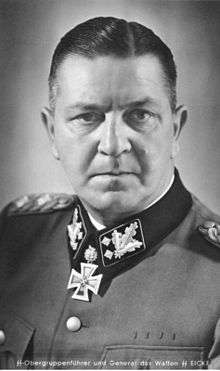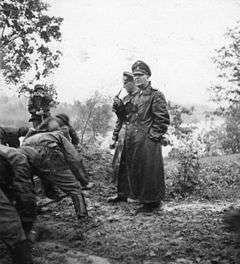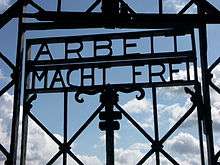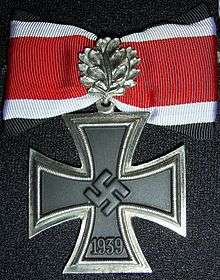Theodor Eicke
| Theodor Eicke | |
|---|---|
 | |
| Born |
17 October 1892 Hudingen, German Empire |
| Died |
26 February 1943 (aged 50) near Kharkov, Soviet Union |
| Allegiance | |
| Service/branch |
Bavarian Army |
| Years of service |
1909–19 (Bavaria) 1930–1945 (SS) |
| Rank | Obergruppenführer |
| Service number |
NSDAP #114,901 SS #2,921 |
| Unit | SS-Totenkopfverbände |
| Commands held |
Dachau concentration camp SS Division Totenkopf |
| Battles/wars | World War II |
| Awards | Knight's Cross of the Iron Cross with Oak Leaves |
Theodor Eicke (17 October 1892 – 26 February 1943) was an SS-Obergruppenführer (German General), commander of the SS-Division (mot) Totenkopf of the Waffen-SS and one of the key figures in the establishment of concentration camps in Nazi Germany. Together with his adjutant SS-Obersturmbannführer Michael Lippert, Eicke executed SA Chief Ernst Röhm following the Night of the Long Knives purge in 1934.[1]
Early Life — World War I
Eicke, the son of a station master, was born in Hudingen (Hampont), near Salzburg (Château-Salins) (then in the German province of Elsass-Lothringen) into a lower-middle-class family. The youngest of 11 children, he did not do well in school and dropped out at the age of 17 before graduation. He joined the 23rd Bavarian Infantry Regiment as a volunteer; later on, in World War I, he took the office of paymaster for the 3rd — and, from 1916 on, the 22nd Bavarian Infantry Regiment. He won the Iron Cross, Second Class in 1914.[2]
Eicke resigned from his position of army paymaster in 1919.[3] He began studying in his wife's hometown of Ilmenau. However, he dropped out of school again in 1920 intending to pursue a police career. He initially worked as an informer and later as a regular policeman. His career in the police came to an end because of his fervent hatred for the Weimar Republic and his repeated participation in violent political demonstrations.[3] He finally managed to find work in 1923 at IG Farben.
Nazi activist
Eicke's views on the Weimar Republic mirrored those of the Nazi Party, which he joined as member number 114,901, along with Ernst Röhm's SA on 1 December 1928.[4] He left the SA in August 1930 for the SS (member # 2,921), where he quickly rose in rank after recruiting new members and building up the SS organization in the Bavarian palatinate. In 1931, Eicke was promoted to the rank of SS-Standartenführer (colonel) by Reichsführer-SS Heinrich Himmler.[3]
His political activities caught the attention of his employer and in early 1932 he was laid off by IG Farben. At the same time, he was caught preparing bomb attacks on political enemies in Bavaria for which he received a two-year prison sentence in July 1932.[3] However, due to protection received from Franz Gürtner, who would later serve as minister of justice under Adolf Hitler, he was able to flee to Italy on orders from Heinrich Himmler.
Rise in the SS
In March 1933, less than three months after Hitler's rise to power, Eicke returned to Germany. Eicke had political quarrels with Gauleiter Joseph Bürckel, who had him arrested and detained for several months in a mental asylum.[4] Also during the same month, Himmler set up the first official concentration camp at Dachau.[5] Hitler had stated that he did not want it to be just another prison or detention camp. In June 1933, Himmler obtained the release of Eicke from the asylum and promoted him to SS-Oberführer (senior colonel). On 26 June 1933, Himmler appointed him commandant of Dachau after complaints and criminal proceedings against former commandant SS-Sturmbannführer Hilmar Wäckerle following the murder of several detainees under the "guise of punishment".[6] Eicke requested a permanent unit and Himmler granted the request; the SS-Wachverbände (Guard Unit) was formed.[7]
Promoted on 30 January 1934 to SS-Brigadeführer (major general), Eicke as commander of Dachau reorganized the camp, firing half of the 120 guards who had been billeted there when he arrived. He devised a system that was used as a model for future camps throughout Germany.[8] He established new guarding provisions, which included rigid discipline, total obedience to orders, and tightening disciplinary and punishment regulations for detainees. Uniforms were issued for prisoners and guards alike; the guards' uniforms had a special death's head insignia on their collars. While this ended the haphazard brutality that had characterized the original camps, Eicke's regulations were very far from humane. Heavy-handed discipline, including death in some cases, was instituted for even trivial offenses.[9] Eicke was known for his "brutality", detested weakness and instructed his men that any SS man with a soft heart should "... retire at once to a monastery".[4][10] Eicke's anti-semitism and anti-bolshevism as well as his insistence on unconditional obedience towards him, the SS and Hitler made an impression on Himmler.[10] In May 1934, Eicke claimed the title of Concentration Camps Inspector for himself.
In early 1934, Hitler and other Nazi leaders became concerned that Ernst Röhm, chief of the SA, was planning a coup d'état.[11] Hitler decided on 21 June that Röhm and the SA leadership had to be eliminated. The purge of the SA leadership and other enemies of the state began on 30 June in an action which became known as the Night of the Long Knives. Eicke, along with hand-chosen members of the Dachau concentration camp guards, assisted Sepp Dietrich's Leibstandarte SS Adolf Hitler in the arrest and imprisonment of SA commanders. After Röhm was arrested, Hitler gave him the choice to commit suicide or be shot. When Röhm refused to kill himself, he was shot dead by Eicke (together with his adjutant, Michael Lippert) on 1 July 1934.[12] Shortly thereafter, Himmler officially named Eicke chief of the Inspektion der Konzentrationslager (Concentration Camps Inspectorate or CCI) and promoted him to the rank of SS-Gruppenführer in command of the SS-Wachverbände. As a result of the Night of the Long Knives, the remaining SA-run camps were taken over by the SS.[4][13][14]
In his role as the Concentration Camps Inspector, Eicke began a large reorganisation of the camps in 1935. The smaller camps were dismantled. Dachau concentration camp remained, then Sachsenhausen concentration camp opened in summer 1936, Buchenwald in summer 1937 and Ravensbrück (near Lichtenburg) in May 1939. There were other new camps in Austria, such as Mauthausen-Gusen concentration camp, opened in 1938.[4] All SS camps' regulations, both for guards and prisoners, followed the Dachau camp model.[8]
Further, in 1935, Dachau became the training center for the concentration camps service.[4] On 29 March 1936, the concentration camp guards and administration units were officially designated as the SS-Totenkopfverbände (SS-TV). Eicke's reorganizations and the introduction of forced labour made the camps one of the SS's most powerful tools; this earned him the enmity of Reinhard Heydrich, who had already unsuccessfully attempted to take control of the Dachau concentration camp in his position as chief of the SD. Eicke prevailed with support from Himmler.
Totenkopf Division

At the beginning of World War II, the success of the Totenkopf's sister formations the SS-Infanterie-Regiment (mot) Leibstandarte SS Adolf Hitler and the three Standarten of the SS-Verfügungstruppe (SS-VT) led to Hitler approving Himmler's recommendation for the creation of three Waffen-SS divisions in October 1939.
SS Division Totenkopf was formed from concentration camp guards of the 1st (Oberbayern), 2nd (Brandenburg) and 3rd (Thüringen) Standarten (regiments) of the SS-Totenkopfverbände, and soldiers from the SS Heimwehr Danzig. Eicke was given command of the division.[4]
After Eicke was reassigned to combat duty, Richard Glücks his deputy, was appointed the new CCI chief by Himmler.[4] By 1940, the CCI came under the administrative control of the Verwaltung und Wirtschaftshauptamt Hauptamt (VuWHA; Administration and Business office) which was set up under Oswald Pohl. Then in 1942, the CCI became Amt D (Office D) of the consolidated SS-Wirtschafts-Verwaltungshauptamt (SS Economic and Administrative Department; WVHA) under Pohl.[15] Therefore, the entire concentration camp system was placed under the authority of the WVHA with the Inspector of Concentration Camps now a subordinate to the Chief of the WVHA.[16] Pohl assured Eicke that the command structure he had introduced would not fall to the jurisdiction of the Gestapo and SD. The CCI and later Amt D were subordinate to the SD and Gestapo only in regards to who was admitted to the camps and who was released.[17] However, what happened inside the camps was under the command of Amt D.[17]
The Totenkopf Division went on to become one of the most effective German formations on the Eastern Front, fighting during the advance in 1941 as well as the summer offensive in 1942, the capture of Kharkov, in the Demyansk Pocket, during the Soviet Vistula–Oder Offensive, and the Battle of Budapest in 1945.[18] During the course of the war, Eicke and his division became known for brutality and war crimes, including the murder of 97 British POWs in Le Paradis in 1940,[19] the murder of captured Soviet soldiers and the plundering and pillaging of several Soviet villages.
Death
Eicke was killed on 26 February 1943,[20] during the opening stages of the Third Battle of Kharkov, when his Fieseler Fi 156 Storch reconnaissance aircraft was shot down. Eicke was portrayed in the Axis press as a hero, and soon after his death one of the Totenkopf's infantry regiments received the cuff-title Theodor Eicke. Eicke was originally buried at a German military cemetery near Orelka, Russia.[21] Later, Himmler ordered Eicke's remains disinterred and reburied at the Hegewald German military cemetery in Zhitomir. In 1944, the Germans were pushed back and forced to retreat yet again. Eicke's corpse was left where it had been re-buried.
Personal life
Eicke married on 26 December 1914. They had two children, Irma (born 5 April 1916) and Hermann (born 4 May 1920, killed in action as Leutnant in the army on 2 December 1941).
Summary of his military career
Dates of rank
- SS-Mann: 29 July 1930
- SS-Truppführer: August 1930
- SS-Sturmführer: 11 November 1930
- SS-Sturmbannführer: 30 January 1931
- SS-Standartenführer: 11 November 1931
- SS-Oberführer: 26 October 1932
- SS-Brigadeführer: 30 January 1934
- SS-Gruppenführer: 11 July 1934 und Generaleutnant der Waffen-SS: September 1941
- SS-Obergruppenführer und General der Waffen-SS: 20 April 1942[2]
Notable decorations
- Honour Cross of the World War 1914/1918 (1934)
- Golden Party Badge (1940)
- SS Honor Ring
- SS Honor Sword
- Iron Cross (1914) 2nd and 1st Class
- Clasp to the Iron Cross (1939)
- Eastern Front Medal (1942)
- Knight's Cross of the Iron Cross with Oak Leaves
- Knight's Cross on 26 December 1941 as SS-Gruppenführer and Generalleutnant of the Waffen-SS and commander of SS-Division "Totenkopf"[23]
- 88th Oak Leaves on 20 April 1942 as SS-Obergruppenführer and General of the Waffen-SS and commander of SS-"Totenkopf" Division[24]
- Wound Badge in Silver[2]
- Bavarian Military Merit Cross 2nd Class (?)[Note 1]
- War Merit Cross, Second Class (Brunswick)
- Mentioned in the Wehrmachtbericht on 21 October 1942
See also
References
Footnotes
- ↑ Eicke was an Unterzahlmeister, assistant paymaster in World War I; this is the class customary for his rank, but sources offer bad translations such as "Bayerische Order of Merit 2. Klasse (WW I)"
Citations
- ↑ Kershaw 2008, p. 312.
- 1 2 3 Ailsby 1997, p. 40.
- 1 2 3 4 Hamilton 1984, p. 261.
- 1 2 3 4 5 6 7 8 McNab 2009, p. 137.
- ↑ Evans 2003, p. 344.
- ↑ Padfield 2001, pp. 128–129.
- ↑ Padfield 2001, p. 129.
- 1 2 Evans 2005, p. 84.
- ↑ Evans 2005, pp. 84–85.
- 1 2 Hamilton 1984, p. 263.
- ↑ Kershaw 2008, pp. 306–309.
- ↑ Stein 1984, p. 8.
- ↑ Kershaw 2008, pp. 308–314.
- ↑ Evans 2005, pp. 31–35, 39.
- ↑ Weale 2012, p. 115.
- ↑ Koehl 2004, pp. 182–183.
- 1 2 Williams 2001, p. 51.
- ↑ McNab 2009, pp. 66–68, 73.
- ↑ Cooper 2004.
- ↑ Flaherty 2004, p. 146.
- ↑ Ripley 2004, p. 59.
- 1 2 Thomas 1997, p. 149.
- ↑ Fellgiebel 2000, p. 171.
- ↑ Fellgiebel 2000, p. 59.
Bibliography
- Ailsby, Christopher (1997). SS: Roll of Infamy. Motorbooks Intl. ISBN 0760304092.
- Cooper, D. (22 February 2004). "WW2 People's War: Le Paradis: The murder of 97 soldiers in a French field on the 26/27th May 1940". BBC Online. Retrieved 22 March 2016.
- Evans, Richard J. (2003). The Coming of the Third Reich. New York: Penguin Group. ISBN 978-0-14-303469-8.
- Evans, Richard J. (2005). The Third Reich in Power. New York: Penguin Group. ISBN 978-0-14-303790-3.
- Fellgiebel, Walther-Peer (2000) [1986]. Die Träger des Ritterkreuzes des Eisernen Kreuzes 1939–1945 — Die Inhaber der höchsten Auszeichnung des Zweiten Weltkrieges aller Wehrmachtteile [The Bearers of the Knight's Cross of the Iron Cross 1939–1945 — The Owners of the Highest Award of the Second World War of all Wehrmacht Branches] (in German). Friedberg, Germany: Podzun-Pallas. ISBN 978-3-7909-0284-6.
- Flaherty, T. H. (2004) [1988]. The Third Reich: The SS. Time-Life. ISBN 1-84447-073-3.
- Hamilton, Charles (1984). Leaders & Personalities of the Third Reich, Vol. 1. R. James Bender Publishing. ISBN 0912138270.
- Kershaw, Ian (2008). Hitler: A Biography. New York: W. W. Norton & Company. ISBN 978-0-393-06757-6.
- Koehl, Robert (2004). The SS: A History 1919–45. Stroud: Tempus. ISBN 978-0-75242-559-7.
- Ripley, Tim (2004). The Waffen-SS at War: Hitler's Praetorians 1925-1945. Zenith Press. ISBN 978-1-86227-248-4.
- McNab, Chris (2009). The SS: 1923–1945. Amber Books Ltd. ISBN 978-1-906626-49-5.
- Padfield, Peter (2001) [1990]. Himmler: Reichsführer-SS. London: Cassel & Co. ISBN 0-304-35839-8.
- Stein, George (1984) [1966]. The Waffen-SS: Hitler's Elite Guard at War 1939–1945. Ithaca, N.Y.: Cornell University Press. ISBN 978-0-8014-9275-4.
- Thomas, Franz (1997). Die Eichenlaubträger 1939–1945 Band 1: A–K [The Oak Leaves Bearers 1939–1945 Volume 1: A–K] (in German). Osnabrück, Germany: Biblio-Verlag. ISBN 978-3-7648-2299-6.
- Weale, Adrian (2012). Army of Evil: A History of the SS. New York; Toronto: NAL Caliber (Penguin Group). ISBN 978-0-451-23791-0.
- Williams, Max (2001). Reinhard Heydrich: The Biography, Volume 1—Road To War. Church Stretton: Ulric Publishing. ISBN 978-0-9537577-5-6.
Further reading
- Sydnor, Jr., Charles W. (1990). Soldiers of Destruction: the SS Death's Head Division, 1933-1945. Princeton University Press, ISBN 0-691-00853-1.
| Military offices | ||
|---|---|---|
| Preceded by SS-Standartenführer Hilmar Wäckerle |
Commander of K.L. Dachau 26 June 1933 – 4 July 1934 |
Succeeded by SS-Oberführer Alexander Reiner |
| Preceded by none |
Commander of 3. SS-Panzer Division Totenkopf 14 November 1939 – 6 July 1941 |
Succeeded by SS-Obergruppenführer Matthias Kleinheisterkamp |
| Preceded by SS-Obergruppenführer Georg Keppler |
Commander of 3. SS-Panzer Division Totenkopf 21 September 1941 – 26 February 1943 |
Succeeded by SS-Obergruppenführer Hermann Prieß |

